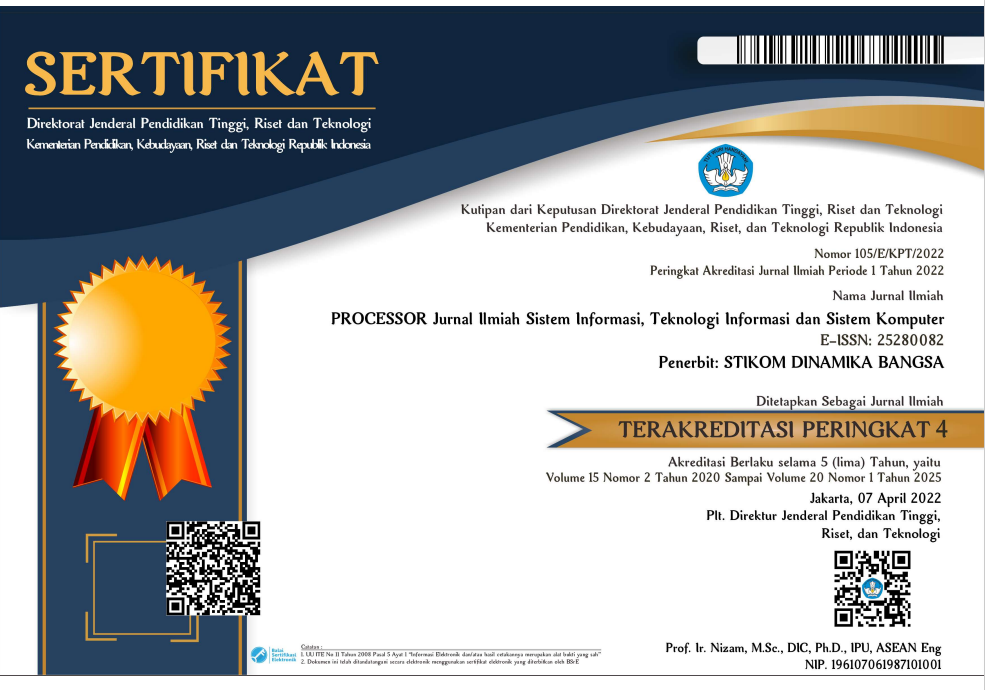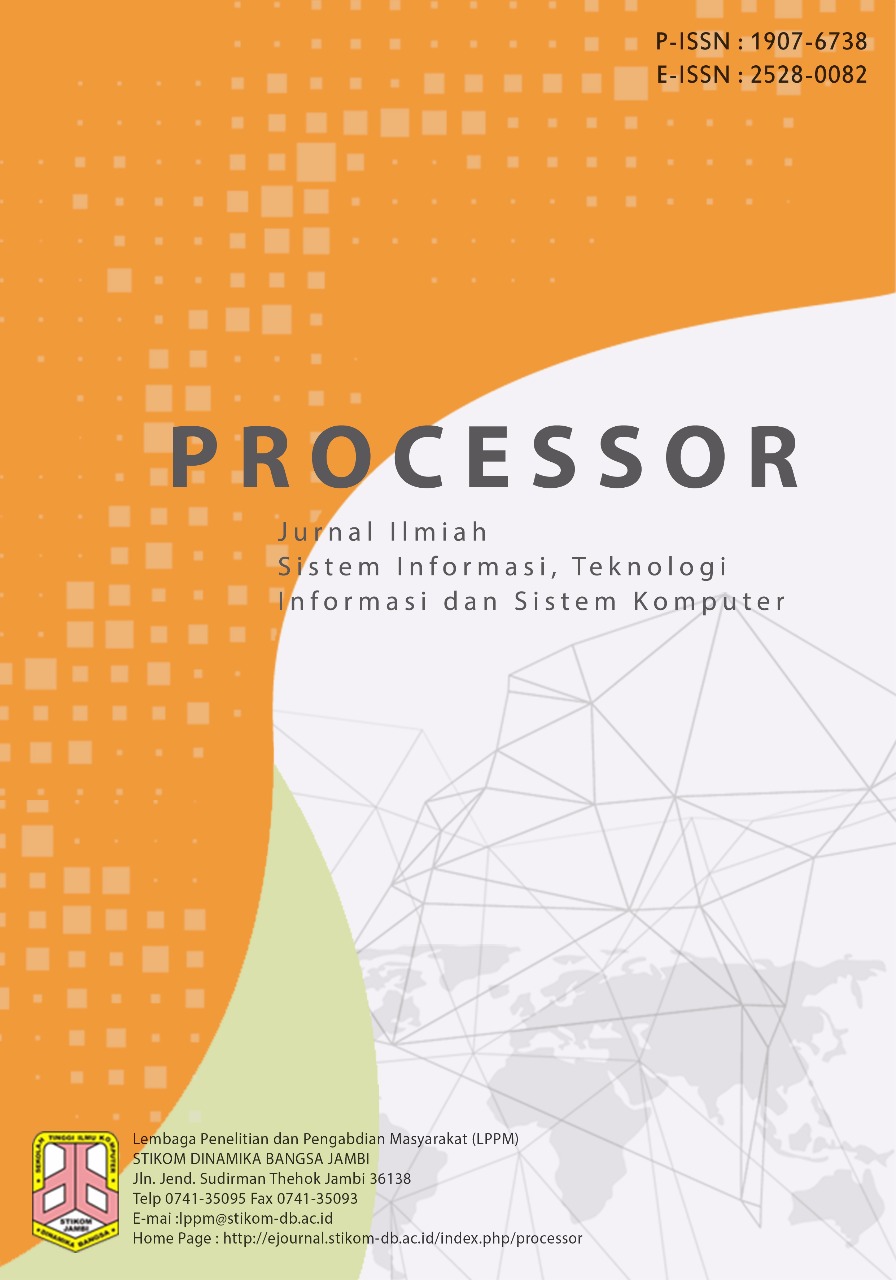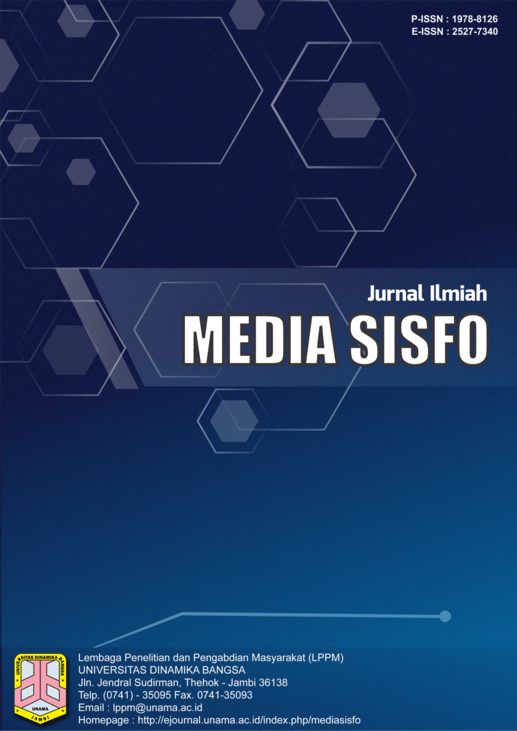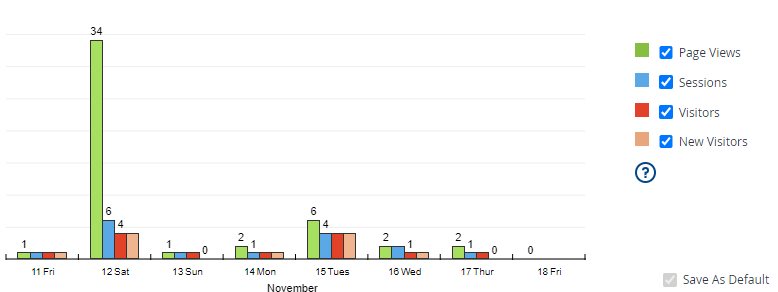English
DOI:
https://doi.org/10.33998/processor.2025.20.1.2206Kata Kunci:
englishAbstrak
Jaringan Ad-hoc Kendaraan (VANET) sangat penting untuk sistem transportasi cerdas modern dan dapat secara signifikan meningkatkan keselamatan jalan raya dan efisiensi lalu lintas melalui komunikasi kendaraan-ke-kendaraan (V2V) yang andal. Penelitian ini berfokus pada peningkatan keselamatan jalan raya dan mengatasi tantangan dalam menjaga komunikasi yang stabil di lingkungan yang dinamis. Kami mengevaluasi kinerja tiga protokol perutean: Ad hoc On-Demand Distance Vector (AODV), Learning Automata-enhanced AODV (LA-AODV), dan Destination-Sequenced Distance Vector (DSDV) dalam berbagai skenario lalu lintas. Kami menggunakan NS-3 untuk simulasi guna menganalisis model lalu lintas perkotaan dan jalan raya di dunia nyata dengan kepadatan kendaraan dan pola mobilitas yang berbeda. Metrik Essential Quality of Service (QoS), termasuk rasio pengiriman paket, rasio kehilangan paket, throughput, penundaan end-to-end, dan jitter, membantu mengidentifikasi protokol yang paling efektif. Temuan kami menunjukkan bahwa LA-AODV secara konsisten mengungguli AODV dan DSDV, terutama dalam pengaturan jalan raya, mencapai throughput sebesar 40,538 Kbps dan rasio packet loss sebesar 73,67%. Namun, optimasi lebih lanjut diperlukan untuk menurunkan penundaan end-to-end untuk aplikasi yang sensitif terhadap waktu. Hasil ini bukan sekedar temuan akademis, namun merupakan alat praktis untuk pengembangan protokol routing VANET yang lebih efisien dan andal. Mereka memberikan wawasan yang dapat ditindaklanjuti yang dapat memberikan informasi dan mempersiapkan Anda untuk meningkatkan komunikasi dalam sistem transportasi cerdas.
Unduhan
Referensi
H. Ouamna, Z. Madini, and Y. Zouine, “Review article: Optimization of a V2V communication in cognitive radio context,” 2021 Int. Conf. Optim. Appl. ICOA 2021, pp. 2–7, 2021, doi: 10.1109/ICOA51614.2021.9442643.
P. Sharma and S. Jain, “Review of VANET challenges and protocol for architecture design and intelligent traffic system,” 2nd Int. Conf. Data, Eng. Appl. IDEA 2020, 2020, doi: 10.1109/IDEA49133.2020.9170685.
M. Khakifirooz, M. Fathi, and L. Du, “Reliability Assessment of Vehicle-to-Vehicle Communication Networks through Headway Distribution and Information Propagation Delay,” Transp. Res. Interdiscip. Perspect., vol. 24, no. February, p. 101053, 2024, doi: 10.1016/j.trip.2024.101053.
D. Chen, M. Zhao, D. Sun, L. Zheng, S. Jin, and J. Chen, “Robust H∞ control of cooperative driving system with external disturbances and communication delays in the vicinity of traffic signals,” Phys. A Stat. Mech. its Appl., vol. 542, p. 123385, 2020, doi: 10.1016/j.physa.2019.123385.
W. Ji et al., “Traffic accidents of autonomous vehicles based on knowledge mapping: A review,” J. Traffic Transp. Eng. (English Ed., vol. 10, no. 6, pp. 1061–1073, 2023, doi: 10.1016/j.jtte.2023.09.003.
U. Archana and A. C. Anilkumar, “A Cognitive V2V Communication System Model Using Active User Cooperation in 3D-GBSM Channel,” 4th Int. Conf. Comput. Commun. Signal Process. ICCCSP 2020, pp. 18–21, 2020, doi: 10.1109/ICCCSP49186.2020.9315286.
A. N. Upadhyaya and J. S. Shah, “AODV routing protocol implementation in VANET,” Int. J. Adv. Res. Eng. Technol., vol. 10, no. 2, pp. 585–595, 2019, doi: 10.34218/IJARET.10.2.2019.055.
K. B. Y. Bintoro and T. K. Priyambodo, “Learning Automata-Based AODV to Improve V2V Communication in A Dynamic Traffic Simulation,” Int. J. Intell. Eng. Syst., vol. 17, no. 1, pp. 666–678, 2024, doi: 10.22266/ijies2024.0229.56.
F. Tabbana, “Performance Analysis of AODV, DSDV and ZRP Routing Protocols for Wireless Sensor Networks using NS2 Tool,” pp. 279–297, 2020, doi: 10.5121/csit.2020.100525.
M. M. Hamdi, L. Audah, S. A. Rashid, A. H. Mohammed, S. Alani, and A. S. Mustafa, “A Review of Applications, Characteristics and Challenges in Vehicular Ad Hoc Networks (VANETs),” HORA 2020 - 2nd Int. Congr. Human-Computer Interact. Optim. Robot. Appl. Proc., 2020, doi: 10.1109/HORA49412.2020.9152928.
S. Salah, R. Zaghal, and M. Abdeljawad, “A Mathematical-Based Model for Estimating the Path Duration of the DSDV Routing Protocol in MANETs,” J. Sens. Actuator Networks, vol. 11, no. 2, 2022, doi: 10.3390/jsan11020023.
A. Al-Ahwal and R. A. Mahmoud, “Performance Evaluation and Discrimination of AODV and AOMDV VANET Routing Protocols Based on RRSE Technique,” Wirel. Pers. Commun., vol. 128, no. 1, pp. 321–344, 2023, doi: 10.1007/s11277-022-09957-8.
K. Bayu, Y. Bintoro, A. Syahputra, A. H. Rismanto, and M. Marchenko, “THE PERFORMANCE ANALYSIS OF REACTIVE AND PROACTIVE ROUTING PROTOCOLS FOR V2V COMMUNICATION IN DYNAMIC TRAFFIC SIMULATION,” J. Tek. Inform., vol. 5, no. 4, pp. 1277–1285, 2024, [Online]. Available: http://jutif.if.unsoed.ac.id/index.php/jurnal/article/view/2237
T. K. Priyambodo, D. Wijayanto, and M. S. Gitakarma, “Performance optimization of MANET networks through routing protocol analysis,” Computers, vol. 10, no. 1, pp. 1–13, 2021, doi: 10.3390/computers10010002.
K. B. Y. Bintoro, T. K. Priyambodo, and Y. P. Sardjono, “Smart AODV routing protocol strategies based on learning automata to improve V2V communication quality of service in VANET,” Kinet. Game Technol. Inf. Syst. Comput. Network, Comput. Electron. Control, vol. 4, no. 3, 2024, [Online]. Available: https://kinetik.umm.ac.id/index.php/kinetik/article/view/1969/124124397
K. Bayu, Y. Bintoro, M. Marchenko, R. C. Saputra, A. Syahputra, and D. National, “Performance Analysis of AODV and DSDV Routing Protocols for UDP Communication in,” Sinkron, vol. 8, no. 4, pp. 2287–2297, 2024.
F. Belamri, S. Boulfekhar, and D. Aissani, “A survey on QoS routing protocols in Vehicular Ad Hoc Network (VANET),” Telecommun. Syst., vol. 78, no. 1, pp. 117–153, 2021, doi: 10.1007/s11235-021-00797-8.
M. Wahl, P. Sondi, and L. Rivoirard, “Enhanced CBL clustering performance versus GRP, OLSR and AODV in vehicular Ad Hoc networks,” Telecommun. Syst., vol. 76, no. 4, pp. 525–540, 2021, doi: 10.1007/s11235-020-00734-1.
K. Afzal, R. Tariq, F. Aadil, Z. Iqbal, N. Ali, and M. Sajid, “An Optimized and Efficient Routing Protocol Application for IoV,” Math. Probl. Eng., vol. 2021, 2021, doi: 10.1155/2021/9977252.
L. Hota, B. P. Nayak, A. Kumar, B. Sahoo, and G. G. M. N. Ali, “A Performance Analysis of VANETs Propagation Models and Routing Protocols,” Sustain., vol. 14, no. 3, pp. 1–20, 2022, doi: 10.3390/su14031379.
A. Bhatia et al., “Networked control system with MANET communication and AODV routing,” Heliyon, vol. 8, no. 11, p. e11678, 2022, doi: 10.1016/j.heliyon.2022.e11678.
B. A. Kumar, M. V. Subramanyam, and K. S. Prasad, “An energy efficient clustering using k-means and AODV routing protocol in Ad-hoc networks,” Int. J. Intell. Eng. Syst., vol. 12, no. 2, pp. 125–134, 2019, doi: 10.22266/IJIES2019.0430.13.
W. Xiong and Q.-Q. Li, “Performance evaluation of data disseminations for vehicular ad hoc networks in highway scenarios,” Int. Arch. Photogramm. Remote Sens. Spat. Inf. Sci., vol. 37, pp. 1015–1020, 2015.
P. K. Shrivastava and L. K. Vishwamitra, “Comparative analysis of proactive and reactive routing protocols in VANET environment,” Meas. Sensors, vol. 16, Aug. 2021, doi: 10.1016/j.measen.2021.100051.
E. Safrianti, L. O. Sari, and F. Saputri, “Performance Analysis Of DSDV, AOMDV and ZRP Routing Protocols Application Simulation In Pekanbaru Vehicular Ad Hoc Network (VANET),” Bul. Pos dan Telekomun., vol. 18, no. 2, pp. 127–144, 2020, doi: 10.17933/bpostel.2020.180204.
A. T. Sasongko, G. Jati, B. Hardian, and W. Jatmiko, “The reliability of routing protocols as an important factor for road safety applications in VANET-based autonomous cars,” J. Comput. Sci., vol. 16, no. 6, pp. 768–783, 2020, doi: 10.3844/JCSSP.2020.768.783.
A. E. Mezher, A. A. AbdulRazzaq, and R. K. Hassoun, “A comparison of the performance of the ad hoc on-demand distance vector protocol in the urban and highway environment,” Indones. J. Electr. Eng. Comput. Sci., vol. 30, no. 3, pp. 1509–1515, 2023, doi: 10.11591/ijeecs.v30.i3.pp1509-1515.
T. Kimura and H. Saito, “Theoretical Broadcast Rate Optimization for V2V Communications at Intersection,” IEEE Trans. Mob. Comput., vol. 21, no. 9, pp. 3360–3372, 2022, doi: 10.1109/TMC.2021.3051956.






















